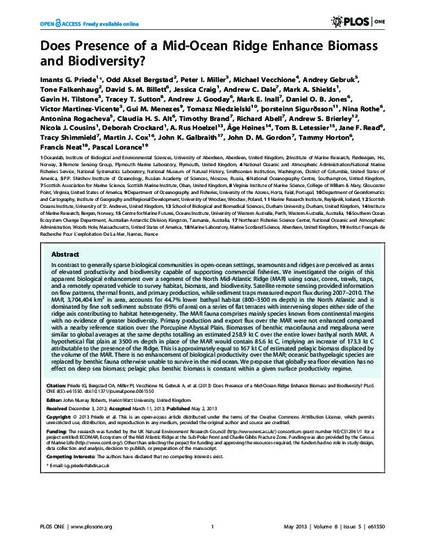
- Oceans,
- Sediment,
- Biodiversity,
- Fishes,
- Deep sea,
- Large animals,
- Atlantic Ocean,
- Aquatic animals
In contrast to generally sparse biological communities in open-ocean settings, seamounts and ridges are perceived as areas of elevated productivity and biodiversity capable of supporting commercial fisheries. We investigated the origin of this apparent biological enhancement over a segment of the North Mid-Atlantic Ridge (MAR) using sonar, corers, trawls, traps, and a remotely operated vehicle to survey habitat, biomass, and biodiversity. Satellite remote sensing provided information on flow patterns, thermal fronts, and primary production, while sediment traps measured export flux during 2007–2010. The MAR, 3,704,404 km2 in area, accounts for 44.7% lower bathyal habitat (800–3500 m depth) in the North Atlantic and is dominated by fine soft sediment substrate (95% of area) on a series of flat terraces with intervening slopes either side of the ridge axis contributing to habitat heterogeneity. The MAR fauna comprises mainly species known from continental margins with no evidence of greater biodiversity. Primary production and export flux over the MAR were not enhanced compared with a nearby reference station over the Porcupine Abyssal Plain. Biomasses of benthic macrofauna and megafauna were similar to global averages at the same depths totalling an estimated 258.9 kt C over the entire lower bathyal north MAR. A hypothetical flat plain at 3500 m depth in place of the MAR would contain 85.6 kt C, implying an increase of 173.3 kt C attributable to the presence of the Ridge. This is approximately equal to 167 kt C of estimated pelagic biomass displaced by the volume of the MAR. There is no enhancement of biological productivity over the MAR; oceanic bathypelagic species are replaced by benthic fauna otherwise unable to survive in the mid ocean. We propose that globally sea floor elevation has no effect on deep sea biomass; pelagic plus benthic biomass is constant within a given surface productivity regime.
Available at: http://works.bepress.com/tracey-sutton/38/

©2013 Priede et al. This is an open-access article distributed under the terms of the Creative Commons Attribution License, which permits unrestricted use, distribution, and reproduction in any medium, provided the original author and source are credited.